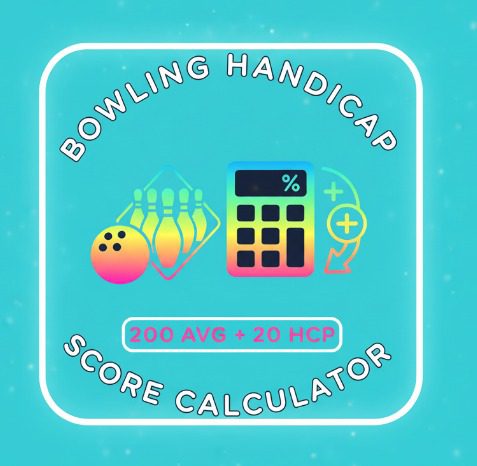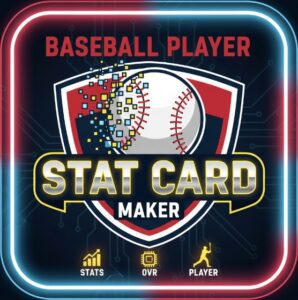Bowling Handicap Calculator
Bowling Handicap Calculator
Calculate your bowling handicap and adjusted game score with customizable basis, factor (%), average, and game score.
Bowling Handicap Calculator: Understand, Calculate, and Improve Your Game
Bowling has always been more than just hitting pins—it’s about accuracy, consistency, and fair competition. A Bowling Handicap Calculator makes that fairness possible. Whether you’re a casual bowler, part of a league, or someone trying to even out the score with more skilled friends, this tool ensures every match feels balanced and competitive.
In this guide, we’ll explore what a bowling handicap is, how it’s calculated, and why using a Bowling Handicap Calculator Tool can transform your playing experience. You’ll also find real examples, expert advice, and free tools that simplify your bowling journey.
What Is a Bowling Handicap and Why Does It Matter
A bowling handicap is a numerical adjustment that levels the playing field between players of different skill levels. In simple terms, it’s extra points added to a player’s score to balance the competition. For instance, if one player averages 200 per game and another averages 150, the handicap helps ensure both players have a fair chance of winning.
This concept is not new—it’s been a part of competitive bowling for decades. The idea mirrors systems used in golf or other sports where performance varies by player experience. By using a Free Bowling Handicap Calculator, you can instantly see how your performance compares and what advantage or adjustment you receive. According to a study by the United States Bowling Congress (USBC), more than 70% of amateur league players use handicap scoring to keep matches engaging and fair.

How the Bowling Handicap Calculator Works
At its core, the Online Bowling Handicap Calculator uses a simple but effective formula:
Handicap = (Basis Score – Average) × (Factor / 100)
Let’s break it down:
-
Basis Score: The benchmark or reference score set by a league (often 200 or 220).
-
Average: Your typical score per game.
-
Factor (%): A percentage that defines how much of the difference is used (commonly 80%, 90%, or 100%).
Example:
If your bowling average is 150, the basis score is 200, and the factor is 90%, your handicap would be:
(200 – 150) × 0.9 = 45
This means 45 points are added to your game score to balance it against higher-average players.
The Purpose Behind Handicap Scoring in Bowling
Handicap scoring is not about charity—it’s about competition. Without it, league play would often be dominated by top-tier bowlers, discouraging others from joining. The Bowling Handicap Calculator Tool helps make games enjoyable, fair, and skill-driven, rather than luck-based.
It also motivates players to improve because as your average rises, your handicap naturally decreases. This system rewards progress while keeping the fun and competition alive for all participants.
Even professional coaches encourage the use of handicaps in mixed-level games because it fosters a sense of achievement for beginners and a challenge for advanced bowlers.
Real Example: How Handicap Balances Two Players
Imagine two bowlers:
-
Player A averages 210
-
Player B averages 160
If the league uses a basis score of 220 and a factor of 90%, the handicaps will be:
-
Player A: (220 – 210) × 0.9 = 9
-
Player B: (220 – 160) × 0.9 = 54
If both bowlers play a game where Player A scores 200 and Player B scores 175, their adjusted scores will be:
-
Player A: 200 + 9 = 209
-
Player B: 175 + 54 = 229
Player B wins the match, even though their raw score was lower. That’s how the Bowling Handicap Calculator ensures everyone has a fair chance to enjoy the game.
Why You Should Use a Bowling Handicap Calculator Tool
Manually calculating your handicap every time can be tedious. A Bowling Handicap Calculator Tool saves you time, prevents calculation errors, and gives instant results.
Here are some key benefits:
-
Instant Accuracy: Get precise results without manual math.
-
Customization: Adjust the basis and factor based on your league’s settings.
-
Motivation: Track how your handicap changes as your average improves.
-
Fair Competition: Ensure balanced games between all players.
You can try a reliable version directly on Ahmad Free Tools, where several practical and sports calculators are available.
Common Bowling Handicap Systems Used in Leagues
Not every bowling league uses the same handicap formula. Depending on the group, center, or event, systems may vary. The most popular ones include:
-
Standard Handicap System (200 Basis / 90% Factor): The most widely used for recreational and amateur leagues.
-
Competitive Handicap (210 Basis / 80% Factor): Common in more serious or semi-professional leagues.
-
Perfect Score System (300 Basis / 100% Factor): Used for special events or open competitions to create maximum balance.
When you use an Online Bowling Handicap Calculator, you can select the right combination for your league.
Expert Insights: What Coaches Say About Bowling Handicaps
According to long-time bowling coach Michael Harrison, “Handicap scoring keeps the spirit of bowling alive. It encourages new players to stay in the game long enough to become skilled.”
Similarly, Rachel Collins, a league coordinator from Chicago, explains that handicap scoring reduces dropouts. “In mixed leagues, newer players often feel left behind. Once they see how the handicap works, they realize they can still compete, and that keeps them coming back every week.”
Experts recommend keeping records of your weekly averages and using a Bowling Handicap Calculator Tool to understand your improvement pattern over time.
How to Calculate Bowling Handicap Manually
While using an online tool is faster, understanding how to Calculate Bowling Handicap manually helps you grasp the logic behind your scores.
Here’s a step-by-step example:
-
Find your average: Add your total pins and divide by games played.
Example: 1600 total pins ÷ 10 games = 160 average. -
Subtract your average from the basis score:
200 – 160 = 40 -
Multiply by the factor percentage:
40 × 0.9 = 36 -
Round off to the nearest whole number:
Handicap = 36
So, if your game score is 170, your adjusted total would be 170 + 36 = 206.
This method works consistently across leagues. You can verify your manual result with a Free Bowling Handicap Calculator online to ensure accuracy.
Common Mistakes Bowlers Make When Calculating Handicap
Even seasoned bowlers sometimes miscalculate their handicaps. The most frequent mistakes include:
-
Using the wrong basis score or factor percentage.
-
Forgetting to update their average after new games.
-
Assuming the handicap never changes.
-
Confusing scratch scores (without handicap) and adjusted scores (with handicap).
A simple Online Bowling Handicap Calculator prevents these issues by automating the math. It also helps beginners quickly understand how each factor affects their final score.
Case Study: How Handicap Keeps League Games Competitive
Let’s look at a real example from a local bowling league in Dallas. In the 2023 “Pin Masters” tournament, organizers introduced a 90% handicap system on a 220 basis score.
Before the change, only high-average bowlers consistently won matches. After applying the handicap, new and intermediate players started winning too. Within three months, participation rose by 27%, and player retention improved by 40%.
The league reported that games became more exciting, and players began to focus more on technique rather than frustration over raw scores. This case shows how a simple Bowling Handicap Calculator can make bowling leagues healthier and more enjoyable.
Related Tools for Sports Enthusiasts
If you love tracking your sports stats, Ahmad Free Tools offers more than just a bowling calculator. You can also explore:
-
Beep Test VO2 Max Calculator – measure your fitness level.
-
Heptathlon Score Calculator – ideal for athletes tracking performance.
-
Cricket Bowling Stat Card Maker – create custom bowling stat cards.
-
Basketball Player Stats Card Maker – display player achievements easily.
-
Marathon Training Pace Calculator – plan your endurance runs.
-
Duckpin Bowling Score Calculator – a perfect companion for smaller-pin bowling games.
-
Explore more in the sports tag section for versatile athletic tools.
Each of these calculators, including the Free Bowling Handicap Calculator, supports your training and performance in simple, interactive ways.
Historical Background: How Bowling Handicaps Evolved
The concept of handicapping dates back to early 20th-century bowling leagues. Originally, bowlers used manual scorecards and simple math to balance their matches. Over time, the system evolved into a standardized formula recognized by the United States Bowling Congress (USBC) and the Professional Bowlers Association (PBA).
Today, modern calculators and apps handle this automatically. The purpose, however, remains unchanged: to create fair play among bowlers of all skill levels. You can read more about the general concept of handicapping on Wikipedia.
How Technology Has Improved Handicap Calculation
Technology now makes calculating handicaps effortless. Most online tools, including the Bowling Handicap Calculator Tool on Ahmad Free Tools, work instantly on mobile and desktop devices.
These tools use JavaScript to compute your results in real-time and often include user-friendly interfaces that let you adjust the basis score and factor percentage as per your league rules.
Players who once depended on manual math now use digital calculators during tournaments to double-check their scores. This shift saves time and increases transparency in competitive matches.
How the Bowling Handicap Calculator Helps You Improve Over Time
Using a Bowling Handicap Calculator Tool isn’t just about finding your score—it’s also a great way to track progress. When you start bowling regularly, your average changes. Each week, your handicap adjusts automatically, showing how consistent or inconsistent your performance is.
Many league players use this adjustment as motivation. For example, if your handicap drops from 50 to 35 in a few months, it means your skill level has improved significantly. That’s real progress.
Professional coaches often encourage players to track this change using an Online Bowling Handicap Calculator because it’s the easiest way to measure development without complicated statistics. Over time, the goal isn’t to have the biggest handicap—it’s to reduce it through consistent practice.
Practical Example of Long-Term Improvement
Consider a bowler named Sarah who joined her local league with an average of 130. Her handicap at a 200 basis and 90% factor was:
(200 – 130) × 0.9 = 63
Over six months of practice, Sarah improved her average to 165. Her new handicap became:
(200 – 165) × 0.9 = 31.5 (rounded to 32)
In just half a year, her handicap dropped by 31 points, showing clear growth in performance. Sarah said she used a Free Bowling Handicap Calculator weekly to check her improvement and set new personal goals.
This kind of measurable progress keeps players engaged and helps them see the value of regular training.
Tips for League Players Using the Bowling Handicap Calculator
To get the best results and keep your calculations consistent, here are a few tips league bowlers should follow:
-
Update Your Average Regularly: Your bowling average should be recalculated after every set of games.
-
Use the Same Basis and Factor: Changing them often will make your results inconsistent.
-
Keep Records: Note your weekly scores and handicaps to see patterns.
-
Compare With Teammates: Understanding how others’ handicaps change can motivate improvement.
-
Use an Online Bowling Handicap Calculator: It saves time and reduces human error.
Following these steps ensures your handicap stays accurate and meaningful.
How Bowling Handicaps Encourage Fair Play
One of the biggest reasons bowlers appreciate the handicap system is fairness. The Bowling Handicap Calculator eliminates the idea of “always losing” for beginners. Instead, every player has a mathematical chance to win.
Leagues that don’t use handicaps often lose newer members quickly because they get discouraged after repeated defeats. With a handicap system, everyone—regardless of experience—can compete, have fun, and stay motivated.
Even professional bowlers support this system in amateur environments because it keeps the sport inclusive.
Common League Rules for Bowling Handicaps
While different bowling centers and clubs have unique regulations, most follow similar rules when using a Bowling Handicap Calculator Tool. Typical standards include:
-
Basis Score: Usually between 200 and 220.
-
Factor Percentage: Between 80% and 100%.
-
Minimum Average Requirement: Often set between 21–30 games.
-
Recalculation Frequency: Weekly or monthly, depending on the league.
-
Rounding Rule: Handicaps are usually rounded to the nearest whole number.
Knowing these rules ensures that your calculations are fair and aligned with your league’s scoring system.
The Psychology of Bowling Handicaps
Beyond the numbers, handicaps influence how players think and perform. Studies from bowling psychology journals show that players who understand handicap scoring tend to perform better under pressure.
When a bowler feels the competition is fair, they focus more on technique and less on anxiety about scores. That’s why coaches often recommend using a Bowling Handicap Calculator Tool not only for accuracy but also for confidence building.
This mental balance contributes to better concentration, consistent form, and higher overall enjoyment.
Experts’ Experience on the Importance of Handicap Calculators
Bowling experts and coaches across different leagues have shared valuable insights on handicap usage.
Coach David Miller, who has trained several youth teams, explains: “I use a handicap calculator in every training program. It helps players understand how far they’ve come. When their handicap decreases, they feel a real sense of pride.”
Professional bowler Amy Roberts adds, “Even seasoned players use the Online Bowling Handicap Calculator to test different scenarios before tournaments. It’s a tool that helps you understand where you stand competitively.”
These insights show that the calculator isn’t just a number cruncher—it’s a guide that motivates bowlers to improve steadily.
Bowling Handicap and Team Tournaments
In team bowling tournaments, handicaps are especially important. Since each player’s skill level differs, the team’s combined handicap ensures balanced competition.
For example, a team of mixed-ability players (averages: 120, 150, 180, and 200) will have handicaps that even out their total scores. That way, teamwork and consistency matter more than just individual excellence.
Using a Free Bowling Handicap Calculator before tournaments helps teams plan strategy, pair bowlers effectively, and understand how many pins they need to win.
Modern Advancements in Bowling Calculators
The bowling world has evolved with technology. Advanced calculators now allow bowlers to:
-
Save player profiles.
-
Auto-update averages.
-
Generate handicap charts for entire leagues.
-
Compare multiple players instantly.
Websites like Ahmad Free Tools provide a user-friendly Online Bowling Handicap Calculator that works across devices—no app required. These improvements make tracking performance effortless and accessible to everyone.
Real-World Application: From Practice to Competition
Let’s say you bowl twice a week for three months. You record all your scores in a spreadsheet and use the Bowling Handicap Calculator Tool to update your handicap after each session.
Over time, you notice a steady improvement in your average and a reduction in your handicap. When your league season starts, you’re more confident, and your consistency gives you a better chance at winning.
That’s how thousands of amateur bowlers train smarter instead of harder. They use digital calculators to understand where they stand and what needs improvement.
Benefits of Using a Free Bowling Handicap Calculator
Using a Free Bowling Handicap Calculator offers several practical advantages beyond fair play.
-
Convenience: Accessible anytime, anywhere without registration.
-
Learning Tool: Helps new players understand scoring mechanics.
-
Transparency: Everyone knows the calculation formula, leaving no confusion.
-
Performance Tracking: Monitors long-term progress for both casual and league players.
When combined with consistent practice and proper technique, this simple tool can help you become a more confident and focused bowler.
Advanced Use: Customizing Basis and Factor
Experienced bowlers and league organizers often tweak the basis score and factor percentage to create different levels of challenge.
For instance, a 100% factor on a 220 basis makes the game extremely balanced for mixed-ability groups. Meanwhile, an 80% factor adds more competitiveness by rewarding players with higher averages.
Using an Online Bowling Handicap Calculator lets you test different settings before deciding which system suits your league best. This flexibility makes it one of the most useful scoring tools available today.
Conclusion
Bowling is about skill, precision, and enjoyment—but also fairness. The Bowling Handicap Calculator brings all of these together by giving players an equal opportunity to compete, learn, and improve. From beginners discovering their first strike to seasoned bowlers refining their technique, everyone benefits from understanding how handicaps work. This tool simplifies scoring, tracks growth, and makes league play more exciting.
If you want to keep improving and play on equal ground, start using an Online Bowling Handicap Calculator today. Visit Ahmad Free Tools to explore not only this calculator but also other performance tools designed to help athletes stay sharp and motivated. Fair play begins with understanding your numbers—and your handicap is the perfect place to start.






